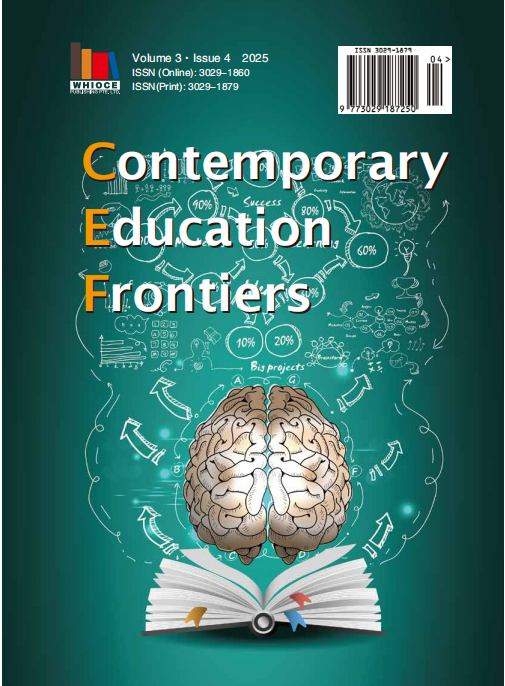Educational Equity in the Algorithmic Era: Gender Equality Challenges and Strategic Responses in Digital Intelligence-Driven Educational Transformation
DOI:
https://doi.org/10.18063/cef.v3i4.1038Keywords:
Educational technology, Gender equality, Algorithmic bias, Symbolic monopolyAbstract
This study demonstrates that the deployment of digital intelligence technologies in education has not only fallen short of delivering equitable outcomes but has systematically intensified gender disparities through three fundamental mechanisms: institutionalized algorithmic bias, symbolic monopoly, and the erasure of labor. Within the context of declining birthrates and population aging, technological alienation has further constrained female development—reducing mothers to “education workers” saddled with “digital domestic management” while marginalizing elderly women in digital learning spaces. The research contends that education systems must embrace their “remediation” imperative by deliberately aligning technological frameworks with gender justice principles. Empirical studies confirm that algorithmic auditing can demystify technological black boxes, STEM quota policies can challenge symbolic monopolies, and digital labor quantification can expose hidden exploitation. These reforms carry strategic importance in the context of demographic transitions: reducing maternal burdens to support fertility rates, advancing age-friendly technology democratization to address population aging, and safeguarding algorithmic equity to prevent female exclusion from AI-dominated future workplaces—collectively fostering a lifelong learning environment that supports family formation, embraces all ages, and ensures technological justice.
References
Alabi, M. (2024). Empowering Women Through Lifelong Learning and Continuing Education Opportunities.
MOE. (2018). Implementation Recommendations for Educational Informationization 2.0 Action Plan. Retrieved 2018.04.13 from http://www.moe.gov.cn/srcsite/A16/s3342/201804/t20180425_334188.html
Wajcman, J. (2010). Feminist theories of technology. Cambridge journal of economics, 34(1), 143-152.
Cooper, J. (2006). The digital divide: The special case of gender. Journal of computer assisted learning, 22(5), 320-334.
Van Dijk, J. A. (2005). The deepening divide: Inequality in the information society. Sage publications.
Subrahmanian, R. (2005). Gender equality in education: Definitions and measurements. International Journal of Educational Development, 25(4), 395-407.
Shapiro, J. R., & Williams, A. M. (2012). The role of stereotype threats in undermining girls’ and women’s performance and interest in STEM fields. Sex roles, 66, 175-183.
Wajcman, J. (1991). Feminism confronts technology. Penn State Press.
Noble, S. U. (2018). Algorithms of oppression: How search engines reinforce racism. In Algorithms of oppression. New York university press.
Suchman, L. A. (2007). Human-machine reconfigurations: Plans and situated actions. Cambridge university press.
Hochschild, A. R. (2001). The time bind: When work becomes home and home becomes work. Metropolitan books.
Freire, P. (2020). Pedagogy of the oppressed. In Toward a sociology of education. Routledge, 374-386.
Watters, A. (2023). Teaching machines: The history of personalized learning. MIT Press.
Foucault, M. (1979). Discipline and punish: the birth of the prison. NY.: Vintage.
Eubanks, V. (2018). Automating inequality: How high-tech tools profile, police, and punish the poor. St. Martin's Press.
O'neil, C. (2017). Weapons of math destruction: How big data increases inequality and threatens democracy. Crown.
UNESCO. (2024). Global education monitoring report 2024, gender report: technology on her terms. Retrieved from https://unesdoc.unesco.org/ark:/48223/pf0000391998?posInSet=1&queryId=5b347c59-44f1-4588-b19d-c77a831eb196
Sousa, E. K. S., Morais, E. J. d. S. d., Amorim, F. C. M., Oliveira, A. D. d. S., Sousa, K. H. J. F., & Almeida, C. A. P. L. (2020). Elaboration and validation of an educational technology related to violence against women. Escola Anna Nery, 24, e20190314.
Qi, W., Qi, X., & Ma, W. (2022). The Impact of Internet Usage on Non-agricultural Employment of Rural Women: Its Theoretical Logic and Chinese Experience. Journal of Beijing Normal University(Social Sciences) (6), 124-133.
Chen, K., & Lou, V. W. (2023). Developing an online learning tool to improve financial literacy in older adults: an intergenerational co-design case study. International Conference on Human-Computer Interaction.
Wilson-Menzfeld, G., Gates, J. R., Moreland, M., Raw, H., & Johnson, A. (2023). Learning digital skills online: empowering older adults through one-to-one, online digital training provision. Frontiers in Psychology, 14, 1122277.
Vaillancourt, M. (2015). Mediated motherhood: discourse and maternal identity in the digital age Syracuse University.
Noble, S. U. (2018). Algorithms of oppression: How search engines reinforce racism. In Algorithms of oppression. New York university press.
Cao, X. (2025). Research on the Path of Social Work Helping E-Commerce Empowering Rural Women’s Development in the Context of “Internet+”. E-Commerce Letters, 14, 2255.
Gray, M. L., & Suri, S. (2019). Ghost work: How to stop Silicon Valley from building a new global underclass. Harper Business.
Selwyn, N. (2021). Education and technology: Key issues and debates. Bloomsbury Publishing.
Dastin, J. (2022). Amazon scraps secret AI recruiting tool that showed bias against women. In Ethics of data and analytics (pp. 296-299). Auerbach Publications.
Bourdieu, P. (1991). Language and symbolic power. Harvard University Press.
Luke, C. (1994). Feminist pedagogy and critical media literacy. Journal of communication inquiry, 18(2), 30-47.
Margolis, J., & Fisher, A. (2002). Unlocking the clubhouse: Women in computing. MIT press.
Steinmacher, I., Trinkenreich, B., Sarma, A., & Gerosa, M. (2024). Breaking the Glass Floor for Women in Tech. In Equity, Diversity, and Inclusion in Software Engineering: Best Practices and Insights. Apress Berkeley, CA, 55-66.

